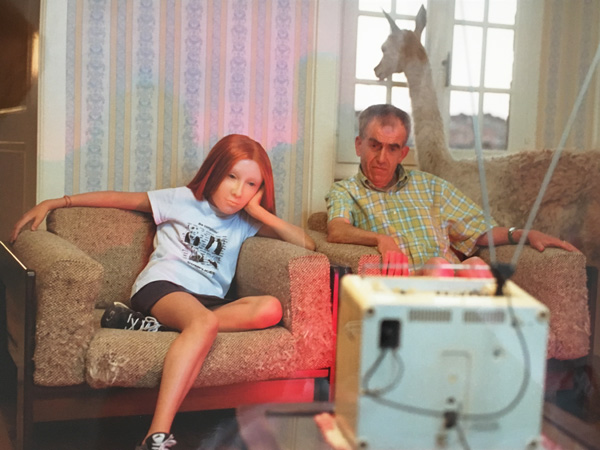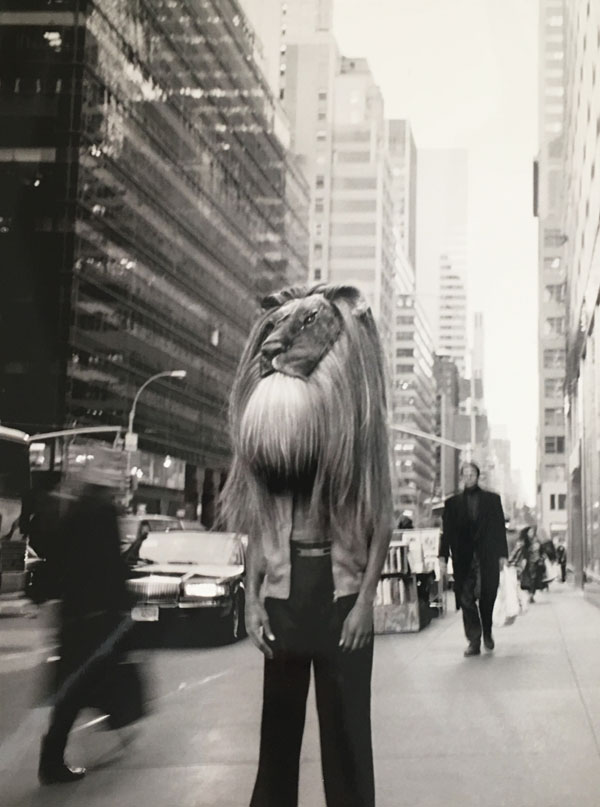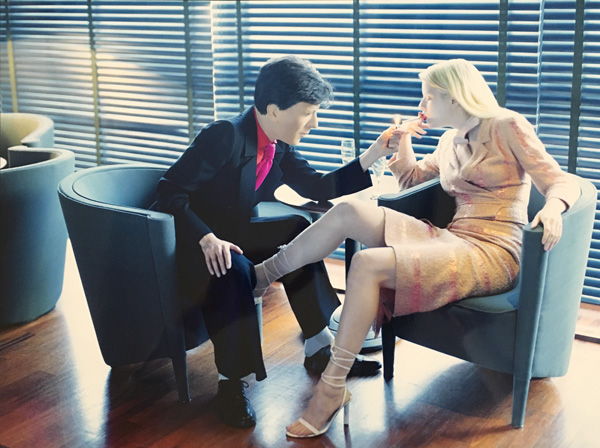For over twenty years, artist
Jean-Pierre Khazem has played a major role in contemporary art. He has been using multiple media to question identity, its definition and its representation - topical subjects that we find ourselves reviewing time and again in contemporary culture. From photography and sculpture to performance and film, the fundamental issues with which they deal; the body, personal existence, fantasy and fetishism, unite the variety of Khazem’s work.
In this article we find the artist striving to overcome the inherent pretence of performance in modelling, to portray a deeper truth via body language, and we see that facial masks have become an indispensable device in achieving this, to date.
The masks donned by Khazem’s subjects, extend the artist’s control of the situation, supplanting the models’ identities and idiosyncrasies with his own creations. Striking a pose is not only an attitude that the body assumes; it also connotes an artificial way of behaving. This falsity in one’s conduct reveals a pretence that has often been ascribed to the modelling industry and Khazem’s use of masks discusses the question of pretence in posing, identifying it as an instinctive response to modern-day ‘surveillance society’. For Khazem, to strike a pose is not only to recognize that you are being watched, it is also to subversively accept that condition and unknowingly or not, exploit it by exaggerating posture and conduct. By wearing masks, Khazem’s models and performers are not made self-conscious by the camera’s presence, thus their actions are not influenced by the awareness of its voyeuristic gaze and respond fully to the narrative that the image sets up.

JEAN-PIERRE KHAZEM
Untitled V14, 1999
Edition of 1000
40(w) x 30(h) cm
15.94(w) x 12.01(h) inches

JEAN-PIERRE KHAZEM
Untitled V14, 1999
Edition of 1000
40(w) x 30(h) cm
15.94(w) x 12.01(h) inches
|
|
|
40(w) x 30(h) cm
15.94(w) x 12.01(h) inches
|
Cibachrome
Only 100 printed of full edition.
Edition of 1000
|
|
Khazem’s masks don’t only serve the purpose of relaxing his models however, indeed they have a core role, to hide but also to reveal the essence of the artist’s message via scenes that range from the cartoonish to the fantastic, from the sublime to the ridiculous. In
Untitled V14, a work from the artist’s ‘Llama series’, a young girl appears to watch TV with her father. However something is amiss as her smooth, expression-less face has an empty, fixed stare, frozen in inactivity. Is the program she’s watching paused? Or in fact is it she herself who is in ‘pause mode’, her demeanour that of a robot or mechanical doll which isn’t ‘activated’? If she wasn’t ‘switched’ off, then how would she be (as she is) oblivious to the presence of the wooly llama next to her?
In another study a of female model, her limp limbs and oversized head-mask are reminiscent of a puppet-doll lying dormant in a hallway. Her passive and stilted pose serve to dehumanize her, reminding us that the flesh is a transient vehicle for the soul, which can appear entirely vacant from the body when facial expressions are obscured. The impassive stare of this character in
Numero, or ‘number’ along with the title of the work, allude perhaps to the number of people that have visited her bedroom, which our imagination tells us is upstairs within this cheap-looking hostel. Its dingy decor, coupled with her desultory expression and figure, languishing on the staircase, suggest her ‘availability’, although her mask evokes a deadpan expression; deflating any emotion between her and the disappearing lover that the scene might otherwise have generated.

JEAN-PIERRE KHAZEM
Broadway, 1999
Edition of 1000
30(w) x 40(h) cm
12.01(w) x 16.02(h) inches

JEAN-PIERRE KHAZEM
Broadway, 1999
Edition of 1000
30(w) x 40(h) cm
12.01(w) x 16.02(h) inches
|
|
|
30(w) x 40(h) cm
12.01(w) x 16.02(h) inches
|
Cibachrome
Only 100 printed of full edition.
Edition of 1000
|
|
Outside of his staged shots, when Khazhem’s image is located in the familiar 'real' world of buildings and traffic, his photographs invite conjecture about the identity of the artist as well as the model. That man in the lion's head in the street - who is he? Maybe that's Khazem under the mask in this print,
Broadway. Maybe, as an artist, Khazem can adopt any disguise he likes; maybe he's inside the trouser-suits of every male figure in his compositions. But we're not sure, and it's disconcerting. But herein is the crux of the photographer’s work which deliberately perturbs, it disorients; and even more so when characters aren’t simply inert, but are actually interacting with one another.

JEAN-PIERRE KHAZEM
Briquet, 1999
Edition of 1000
40(w) x 30(h) cm
15.94(w) x 11.89(h) inches

JEAN-PIERRE KHAZEM
Briquet, 1999
Edition of 1000
40(w) x 30(h) cm
15.94(w) x 11.89(h) inches
|
|
|
40(w) x 30(h) cm
15.94(w) x 11.89(h) inches
|
Cibachrome
Only 100 printed of full edition.
Edition of 1000
|
|
The strong sexual undertone in the rare interaction between the characters in
Briquet is so strange and clinical-seeming, because not only is the exchange again between masked individuals, but it’s exposed, in an office - and under harsh halogen light-bulbs. The ‘briquet’, or lighter is igniting the passion between them which is playing out via the shoe-tip between his legs. Here it might be that Khazem is seeing how far he can go in implying a bizarre porn situation between or with dummies - repelling the senses with the impossibility of the situation, or are we highly amused in fact at the sense of the absurd, and the humerous and see it as light-hearted play?
Whichever way we take them, Khazem's works generate both alluring and alienating sensations and they test where conventional beauty and attraction begins and ends. We are left with the sense that in this day and age, the genuine attainment of physical perfection can also constitute disfigurement, and ultimately blankness. Khazem’s career has not only innovatively highlighted contemporaneous subjects, but has led him to expand the borders of imagination within art itself, and to connect real characters with invented figures. He ceaselessly questions the construction of our identity through the use of masks; the exposure of the body and the disconnection between specific characters and their context.
Of the four exclusive photographic editions released in collaboration with
Jean-Pierre Khazem, three are available;
Briquet,
Untitled V14 and
Broadway. You can also find out more his artist pager
here.